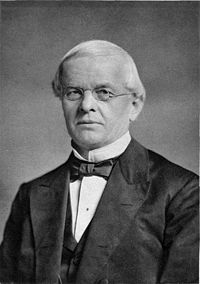August Dillmann
| Christian Friedrich August Dillmann | |
|---|---|
 |
|
| Born |
25 April 1823 Illingen, German Confederation |
| Died | 7 July 1894 (aged 71) Berlin, German Empire |
| Occupation | Orientalist and biblical scholar |
| Nationality | German |
| Education | University of Tübingen |
|
|
|
| Signature | |
Christian Friedrich August Dillmann (25 April 1823 – 7 July 1894) was a German orientalist and biblical scholar.
The son of a Württemberg schoolmaster, he was born at Illingen. He was educated at the University of Tübingen, where he became a pupil and friend of Heinrich Ewald, and studied under Ferdinand Christian Baur, though he did not join the new Tübingen school. For a short time he worked as pastor at Sersheim, near his native place, but he soon came to feel that his studies demanded his whole time.
He devoted himself to the study of Ethiopic manuscripts in the libraries of Paris, London and Oxford, and this work caused a revival of Ethiopic study in the 19th century. In 1847 and 1848 he prepared catalogues of the Ethiopic manuscripts in the British Museum (now the British Library) and the Bodleian Library at Oxford. He then set to work upon an edition of the Ethiopic Bible.
Returning to Tübingen in 1848, in 1853 he was appointed professor extraordinarius. Subsequently he became professor of philosophy at the University of Kiel (1854), and of theology in Giessen (1864) and Berlin (1869), where he succeeded Ernst Wilhelm Hengstenberg.
In 1851 he had published the "Book of Enoch" in Ethiopian (German, 1853; English, 1893), and at Kiel he completed the first part of the Ethiopic bible, Octateuchus Aethiopicus (1853–55). In 1857 appeared his Grammatik der äthiopischen Sprache (2nd edition by Carl Bezold, 1899); in 1859 the "Book of Jubilees"; in 1861 and 1871 another part of the Ethiopic bible, Libri Regum; in 1865 his great Lexicon linguæ aethiopicæ; in 1866 his Chrestomathia aethiopica.
...
Wikipedia
